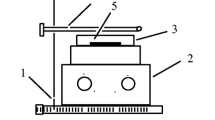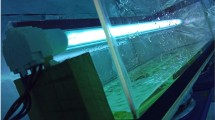Abstract
In this study, the degradation of dimethyl phthalate (DMP), taken as model compound for phthalate esters, by the photo-assisted peroxymonosulfate (PMS) process was investigated. The high oxidation potential of hydroxyl and sulfate radicals generated by the activation of PMS under UV-C light irradiation was used to completely oxidize aqueous DMP solutions. Experiments were conducted at varying initial pH values (3.0, 6.0, and 9.0) and PMS concentrations (0–60 mM) to evaluate the effect of different reaction conditions on DMP treatment performance with the PMS/UV-C process. It was observed that lowering the initial reaction pH slightly improved the degradation rate of DMP. On the contrary, TOC abatements were slightly enhanced with increasing initial reaction pH. An adequate (optimum) PMS concentration of 40 mM resulted in the fastest and highest DMP degradation rates and efficiencies, respectively. At an initial concentration of 100 mg L-1, more than 95% DMP removal was obtained after only 20 min under PMS/UV-C treatment conditions. For the proposed adequate PMS concentration (40 mM) the lowest electrical energy per order (EE/O) value was calculated as 2.9 kW h m−3 order-1.
Similar content being viewed by others
References
R. Benson, Hazard to the developing male reproductive system from cumulative exposure to phthalate esters-10 -dibutyl phthalate, diisobutyl phthalate, butylbenzyl phthalate, diethylhexyl phthalate, dipentyl phthalate, and 11 diisononyl phthalate, Regul. Toxicol. Pharmacol., 2009, 53, 90–101.
T. Fukuwatari, Y. Suzuki, E. Sugimoto and K. Shibata, Elucidation of the toxic mechanism of the plasticizers, phthalic acid esters, putative endocrine disrupters: Effects of dietary di(2-ethylhexyl)phthalate on the metabolism of tryptophan to niacin in rats, Biosci., Biotechnol., Biochem., 2002, 66, 705–710.
S. Takeuchi, M. Lida, S. Kobayashi, K. Jin, T. Matsuda and H. Kojima, Differential effects of phthalate esters on transcriptional activities via human estrogen receptors a and b, and androgen receptor, Toxicology, 2005, 210, 223–233.
US EPA, National Primary Drinking Water Regulations, Federal Register; 40 CFR Chapter I, Part 141, US Environmental Protection Agency, Washington, DC, July 1, 1991.
European Union, Council Regulation (EEC), No. 793/93 of 23 March 1993 on the evaluation and control of the risks of existing substances (OJ L 84, 5 April 1993), European Union, Brussels.
J. Wang, L. Chen, H. Shi and Y. Qian, Microbial degradation of phthalic acid esters under anaerobic digestion of sludge, Chemosphere, 2000, 41, 1245–1248.
C. A. Staples, D. R. Peterson, T. F. Parkerton and W. J. Adams, The environmental fate of phthalate esters: a literature review, Chemosphere, 1997, 35, 667–749.
B. L. Yuan, X. Z. Li and N. Graham, Reaction pathways of dimethyl phthalate degradation in TiO2-UV-O2 and TiO2-UV-Fe(VI) systems, Chemosphere, 2008, 72, 197–204.
M. J. Bauer, R. Herrmann, A. Martin and H. Zellmann, Chemody-namics, transport behaviour and treatment of phthalic acid esters in municipal landfill leachates, Water Sci. Technol., 1998, 38, 185–192.
S. Parsons, Advanced Oxidation Processes for Water and Wastewater Treatment. IWA Publishing, London, 2004.
Handbook for Advanced Photochemical Oxidation Processes. EPA/625/R-98/004, US Environmental Protection Agency, Cincinnati, Ohio, 1998.
CCOT, The AOP Handbook, Calgon Carbon Oxidation Technologies, Markham, Ontario, 1995.
J. Fernandez, P. Maruthamuthu and J. Kiwi, Photobleaching and mineralization of Orange II by oxone and metal-ions involving Fenton-like chemistry under visible light, J. Photochem. Photobiol., A, 2004, 161, 185–192.
B. Meunier, Metalloporphyrins as versatile catalysts for oxidation reactions and oxidative DNA cleavage, Chem. Rev., 1992, 92, 1411–1456.
G. P. Anipsitakis and D. D. Dionysiou, Transition metal/UV-based advanced oxidation technologies for water decontamination, Appl. Catal., B, 2004, 54, 155–163.
G. P. Anipsitakis, D. D. Dionysiou and M. A. Gonzalez, Cobalt-mediated activation of peroxymonosulfate and sulfate radical attack on phenolic compounds: Implications of chloride ions, Environ. Sci. Technol., 2006, 40, 1000–1007.
C. J. Liang, I. L. Lee, I. Y. Hsu, C. P. Liang and Y. L. Lin, Persulfate oxidation of trichloroethylene with and without iron activation in porous media, Chemosphere, 2008, 70, 426–435.
L. Eberson, Electron Transfer Reactions in Organic Chemistry, Spring-Verlag, Berlin, 1987.
Y-F. Huang and Y-H. Huang, Behavioral evidence of the dominant radicals and intermediates involved in Bisphenol A degradation using an efficient Co2+/PMS oxidation process, J. Hazard. Mater., 2009, 167, 418–426.
E. Hayon, A. Treinin and J. Wilf, Electronic spectra, photochemistry, and autoxidation mechanism of the sulfite-bisulfite-pyrosulfite systems. SO2−, SO3−, SO4−, and SO5− radicals, J. Am. Chem. Soc., 1972, 94, 47–57.
P. Neta, V. Madhavan, H. Zemel and R. W. Fessenden, Rate constants and mechanism of reaction of SO4− with aromatic compounds, J. Am. Chem. Soc., 1977, 99, 163–164.
G. R. Peyton, The free-radical chemistry of persulfate-based total organic carbon analyzers, Mar. Chem., 1993, 41, 91–103.
P. Neta, R.E: Huie and A. B. Ross, Rate constants for reactions of inorganic radicals in aqueous solution, J. Phys. Chem. Ref. Data, 1988, 17, 1027–1284.
J. W. Petterson, Industrial Wastewater Treatment Technology, 2nd ed., Butterworth, Boston, 1985.
J. Sánchez-Avila, J. Bonet, G. Velasco and S. Lacorte, Determination and occurrence of phthalates, alkylphenols, bisphenol A, PBDEs, PCBs and PAHs in an industrial sewage grid discharging to a Municipal Wastewater Treatment Plant, Sci. Total Environ., 2009, 407, 4157–4167.
Z. L. Ye, C. Q. Cao, J. C. He, R. X. Zhang and H. Q. Hou, Photolysis of organic pollutants in wastewater with 206 nm UV irradiation, Chin. Chem. Lett., 2009, 20, 706–710.
Y. Lu, F. Tang, Y. Wang, J. Zhao, X. Zeng, Q. Luo and L. Wang, Biodegradation of dimethyl phthalate, diethyl phthalate and di-n-butyl phthalate by Rhodococcus sp. L4 isolated from activated sludge, J. Hazard. Mater., 2009, 168, 938–943.
M. Pirsaheba, A-R. Mesdaghiniab, S. J. Shahtaheric and A. A. Zinatizadehd, Kinetic evaluation and process performance of a fixed film bioreactor removing phthalic acid and dimethyl phthalate, J. Hazard. Mater., 2009, 167, 500–506.
I. Nicole, J. De Laat, M. Dore, J. P. Duguet and C. Bonnel, Use of UV radiation in water treatment: measurement of photonic flux by hydrogen peroxide actinometry, Water Res., 1990, 24, 157–168.
F. J. Benitez, J. L. Acero, F. J. Real, F. J. Rubio and A. I. Leal, The role of hydroxyl radicals for the decomposition of p-hydroxy phenylacetic acid in aqueous solutions, Water Res., 2001, 35, 1338–1343.
J. Beltran-Heredia, J. Torregrosa, J. R. Dominguez and J. A. Peres, Kinetics of the oxidation of p-hydroxybenzoic acid by the H2O2/UV system, Ind. Eng. Chem. Res., 2001, 40, 3104–3108.
F. J. Real, F. J. Benitez, J. L. Acero and M. Gonzalez, Removal of diazinon by various advanced oxidation processes, J. Chem. Technol. Biotechnol., 2007, 82, 566–574.
J. Sun, X. Li, J. Feng and X. Tian, Oxone/Co2+ oxidation as an advanced oxidation process: Comparison with traditional Fenton oxidation for treatment of landfill leachate, Water Res., 2009, 43, 4363–4369.
G. P. Anipsitakis and D. D. Dionysiou, Radical generation by the interaction of transition metals with common oxidants, Environ. Sci. Technol., 2004, 38, 3705–3712.
D. L. Ball and J. O. Edwards, The kinetics and mechanism of the decomposition of Caro’s acid (Part I), J. Am. Chem. Soc., 1956, 78, 1125–1129.
E-E. Chang, H-J. Hsing, P-C. Chiang, M-Y. Chen and J-Y. Shyng, The chemical and biological characteristics of coke-oven wastewater by ozonation, J. Hazard. Mater., 2008, 156, 560–567.
A. S. Stasinakis, Use of selected advanced oxidation processes (AOPs) for wastewater treatment - A mini review, Global NEST Journal, 2008, 10, 376–385.
A. Rezaee, M. T. Ghaneian, S. J. Hashemian, G. Moussavi, A. Khavanin and G. Ghanizadeh, Decolorization of reactive blue 19 dye from textile wastewater by the UV/H2O2 process, J. Appl. Sci., 2008, 8, 1108–1112.
M. A. Behnajady, N. Modirshahla and M. Shokri, Photodestruc-tion of Acid Orange 7 (AO7) in aqueous solutions by UV/H2O2: influence of operational parameters, Chemosphere, 2004, 55, 129–134.
I. Arslan-Alaton, A. Akin and T. Olmez-Hanci, An optimization and modeling approach for H2O2/UV-C oxidation of a commercial nonionic textile surfactant using central composite design, J. Chem. Technol. Biotechnol., 2009, 85, 493–501.
P. Gogate and A. Pandit, A review of imperative technologies for wastewater treatment II: hybrid methods, Adv. Environ. Res., 2004, 8, 553–597.
C-H. Wu and H-Y. Ng, Degradation of C.I. reactive red 2 (RR2) using ozone-based systems: Comparisons of decolorization efficiency and power consumption, J. Hazard. Mater., 2008, 152, 120–127.
J. R. Bolton, K. G. Bircger, W. Tumas and C. A. Tolman, Figure-of merit for the technical development and application of advanced oxidation technologies for both electric- and solar-derived systems, Pure Appl. Chem., 2001, 73, 627–637.
N. Daneshvar, A. Aleboyeh and A. R. Khataee, The evaluation of electrical energy per order (EEO) for photooxidative decolorization of four textile dye solutions by the kinetic model, Chemosphere, 2005, 59, 761–767.
Author information
Authors and Affiliations
Corresponding author
Additional information
This paper is published as part of the themed issue of contributions from the 6th European Meeting on Solar Chemistry and Photocatalysis: Environmental Applications held in Prague, Czech Republic, June 2010.
Rights and permissions
About this article
Cite this article
Olmez-Hanci, T., Imren, C., Kabdaşlı, I. et al. Application of the UV-C photo-assisted peroxymonosulfate oxidation for the mineralization of dimethyl phthalate in aqueous solutions. Photochem Photobiol Sci 10, 408–413 (2011). https://doi.org/10.1039/c0pp00173b
Received:
Accepted:
Published:
Issue Date:
DOI: https://doi.org/10.1039/c0pp00173b




